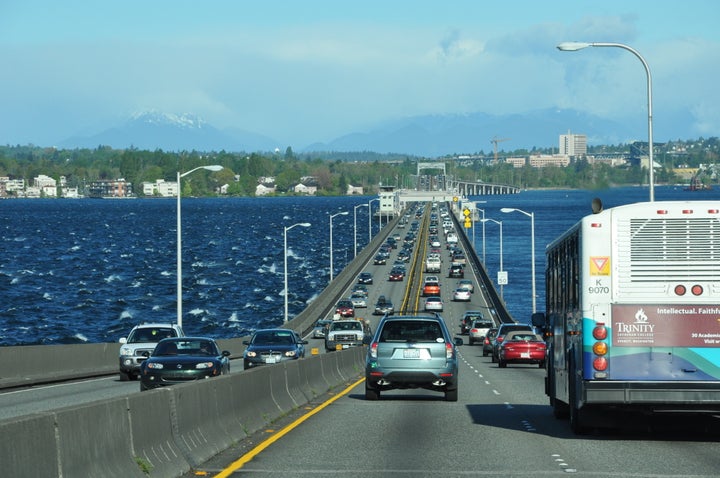
Seattle and its suburbs are divided by Lake Washington, a 33.8-square-mile remnant of the ice ages. The lake presents a formidable obstacle to would-be bridge builders. It is too deep, and its bed too soft, to be spanned by a normal bridge. So almost 50 years ago, Washington state opted for a bridge that floats -- a 7,578-foot monster of a bridge on pontoons.
Now, as the bridge nears the end of its design life, the state is building a brand-new replacement floating bridge. At 7,710 feet, it will be even longer than the old record holder. A single one of its hulking concrete pontoons will be as long as a football field and weigh as much as 23 Boeing 747 jets.

A rendering of the new bridge.
"It's a world-class project," said Craig Stone, toll division director for Washington's Department of Transportation. But a world-class project comes with a world-class price tag: $2.4 billion just for the bridge and associated work. To pay for all that, the state is relying on tolls, the first on the Route 520 bridge since 1979, to raise $1 billion.
The tolls, said Stone, are "essential to our funding package."
They will also serve as a high-profile test of congestion pricing, which economists say could redefine the way Americans commute by offering motorists the chance to pay more for a quicker drive. Before the tolls were instituted, the 520 was often congested. The tolls on the Route 520 bridge will also show whether such "user fees" can help dig America out of its infrastructure hole.
If the tolls succeed, they will be another step on the road toward redefining transportation infrastructure not solely as a public good to be paid for by all but as a scarce good like any other to be purchased on the market.
Drivers "are responding to those price points, definitely," Stone said. According to the transportation department, traffic overall is down 40 percent (the state had guessed a 38 percent decline), but commute times are faster.
All that rational response to price signaling might elicit a smile from a free market enthusiast like Milton Friedman (who proposed an early version of congestion pricing in 1951) or the Bush administration's Department of Transportation (who provided critical funding to institute it in the Seattle region).
Mobile phone app developers have even gotten in on congestion pricing act -- a development that Stone wryly referred to as an example of the state DOT "spurring private innovation."
Gabe Brown is the developer of 520 or 90, one of two apps that use real-time traffic and toll pricing data to help drivers weigh the costs, in time and money, of taking either the Route 520 or the I-90 span, a untolled floating bridge to the south to destinations on both sides of the lake.
Thousands of people have already installed his app to help them make the call, Brown said, adding, "The bulk of our users are preferring to save money right now."
Over the course of a month, paying more to take the Route 520 bridge would save the average user eight hours of travel time a month, he said.
"If you take 90, the slower route but cheaper, you'll save $90 -- the equivalent of dinner for two at the Space Needle. So it's kind of an interesting trade-off that people take," Brown said.
But some worry that if tolls and other "user fees" fix our highways, the low-income drivers who can least afford them will get hurt the most.
"The standard story is they're regressive," said Robert D. Plotnick, a professor at the University of Washington's Evans School of Public Affairs. "Because if you look at the people who use the bridge, by definition when you pay the tolls, it takes a higher portion of your salary if you're poor than if you're rich,"
But in the case of the Route 520 bridge, at least, low-income Seattleites won't be hit very hard, according to a paper by Plotnick backed by funding from the state's transportation department. Very few low-income people, only 1 percent of those in the region, take the bridge. And Washington state's tax structure is "one of the most regressive in the country," said Plotnick, so tolling is better than other ways the bridge might have been paid for, at least in the absence of more federal dollars.
Plotnick cautioned the same conditions might not hold for Atlanta or Los Angeles. "These findings are really specific to Puget Sound," he said. "It really depends on the local characteristics -- where the poor live, where they work."
